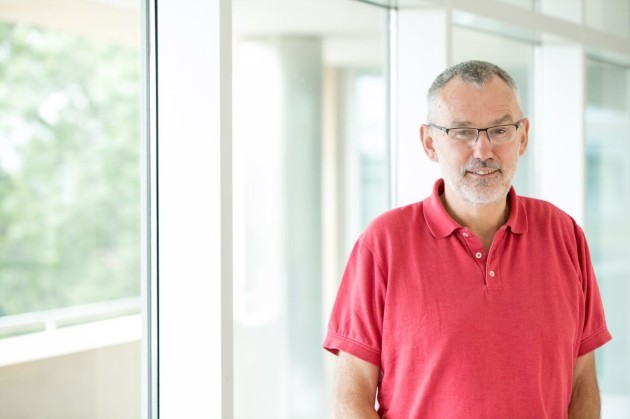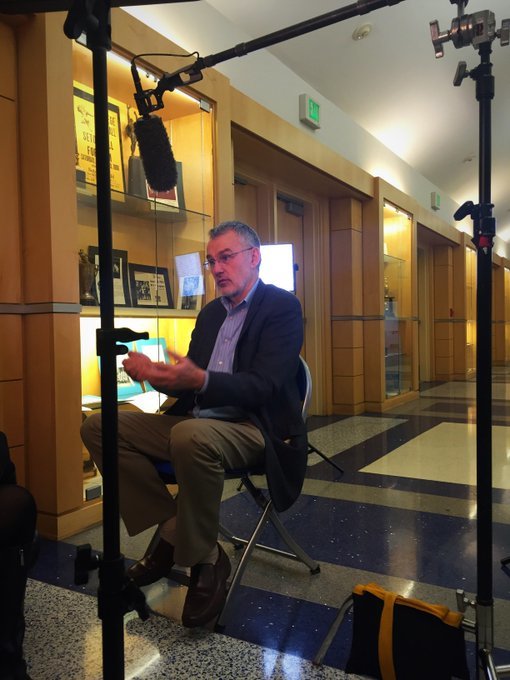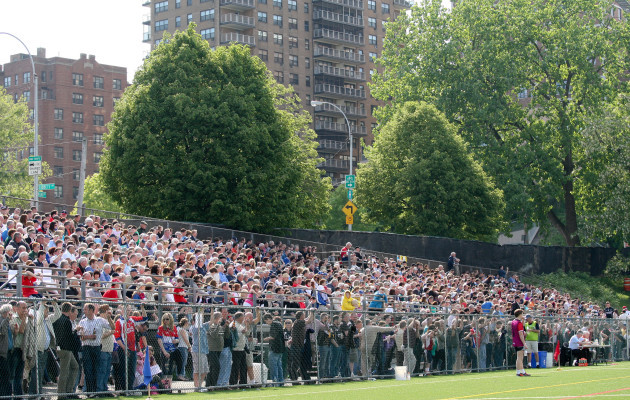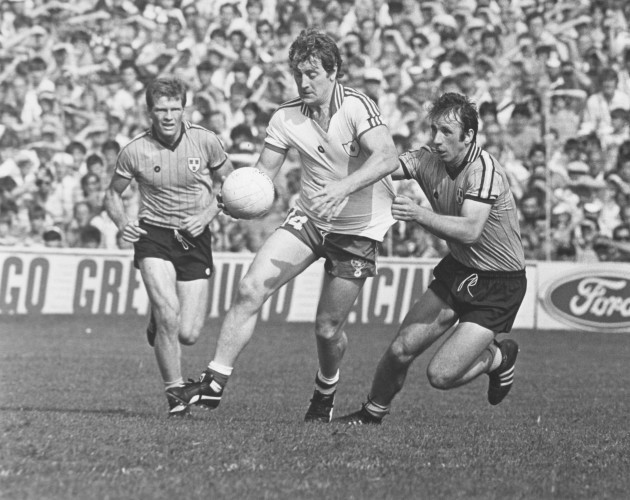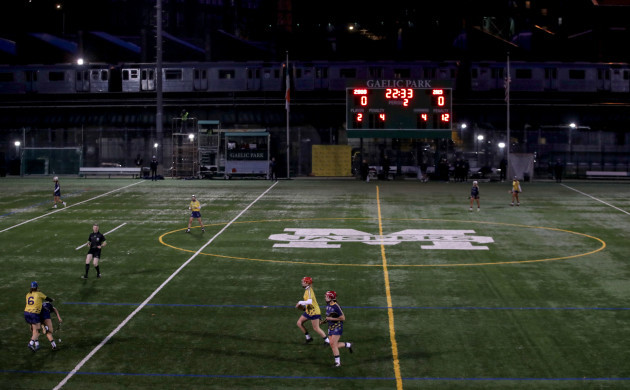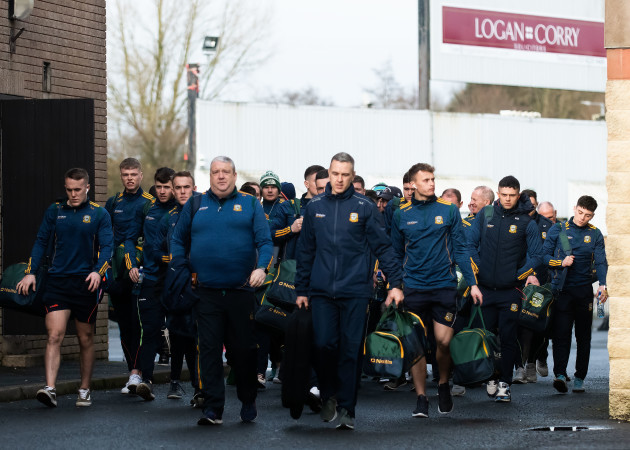IT’S 10 DAYS before Congress selects the next president of the GAA and one of the front-runners for the role is in New Jersey, over 5,000km away from Croke Park, grading university exam papers.
When Cork native Larry McCarthy answers the phone on Wednesday afternoon, he’s sitting in his office working his way through the answer sheets from the 30 students taking his sports marketing class at Seton Hall University.
Professor McCarthy, holder of a PhD in sports management from Ohio State University, works as Associate Professor of Management at Seton Hall which is located about a half an hour drive west of lower Manhattan.
The class is filled with youngsters hoping to embark on careers in the business of sports. Some graduates of the programme have taken up roles in front offices of franchises in the major American sports leagues.
One recent graduate works as social media director for the Brooklyn Nets, while others are employed with the New York Red Bulls and New York Yankees.
“They’re young enough, they’re progressing up the tree a little bit,” he tells The42. “None of them are general managers yet if you know what I mean. But they’re in the business.”
McCarthy’s background puts him in a strong position to win the race to succeed John Horan. He’s thought to be one of the two leading candidates for the role, alongside Jarlath Burns of Armagh.
He has previously held the chairman, secretary and PRO positions within the New York county board. He is currently on the Association’s Management Committee and holds one of the two prestigious GAA trustee positions after topping the polls two years ago.
He also sat on the Strategic Review Committee under John Horan and previously on the Towards 150 Committee under Aogán Ó Fearghail.
He has published articles in academic journals on the management of sport and co-authored a textbook on sports promotion and sales management.
McCarthy makes it clear that he would move to Dublin with his wife Barbara for the duration of his term should he be elected.
“My wife is from Dublin and she won’t have any problem with it,” he says. “And because I work in the university, they’re well used to people coming and going on sabbaticals.”
The past two months have been hectic for the Bishopstown man as he combines his day job with his bid to become the first ‘overseas’ president.
The week before last, he flew out of Newark on Thursday evening. He arrived in Dublin on Friday morning and drove to Mohill the following day to meet with the Leitrim county board. On the Sunday he was in Oranmore for discussions with Galway officers and that evening held talks with some members of the Westmeath county board.
Last weekend he was due to sit down with another four county boards – including Offaly and Monaghan – to discuss his vision for the Association.
“Monday morning I fly back here. I land at lunchtime here in Newark and it’s about 20 minutes away from the house so I’m back in the office on Monday afternoon. And that’s been my life for the last seven or eight weeks.
“It’s mad, you have to put up your hands and say, ‘It is mad’ but I love it. I love going around meeting people and I’ve thoroughly enjoyed it. It’s onerous alright but I get a great kick out it.
“First of all, I tell them I’m coming at this job from a different perspective given my professional background and that I’m looking at sports organisations on a daily basis, seeing what they’re doing well around the world.”
**************
The story of how McCarthy became embedded in New York’s GAA scene will sound familiar to many Irish immigrants in the States.
An All-Ireland club football winner with Limerick’s Thomond College in 1978, he flew out to the Big Apple for the summer two years later without any plans to kick ball.
More by accident than design, his first port of call was to Gaelic Park where he would spend many a Sunday afternoon over the next four decades.
“I was only out for the craic for the summer,” he laughs, “I didn’t know where I was going or what I was doing.
“I met a woman on the plane whose boyfriend I knew and within an hour of landing in Kennedy Airport, I was watching him play football for Sligo football club in Gaelic Park.
“I went training with Sligo on the Tuesday night and I’m with them ever since.”
He was a PE teacher at Malahide Community School at the time. He came back for another couple of summers lining out with Sligo before deciding to move over full-time 1985 to study sports management at New York University.
“The aul brain was going soft so I thought this sport management thing might be interesting,” he says.
He worked with Sligo manager Jimmy Nicholson to sustain him during college. Back then, the New York GAA clubs provided work for their players in different areas. Money from the job was then contributed back to help fund the clubs.
Leitrim would set them up with bar jobs, Longford with roles as doormen. For Sligo, it involved carpentry work. Nicholson’s worked as business head in the carpenter’s union and trained McCarthy up as an apprentice in White Plains.
“I’ve absolutely no hesitation in telling you in about an hours’ time I’ll walk into Seton Hall University and somebody is going to call me ‘professor’ and it’s all because of Jimmy Nicholson.
“Without his help way back then, because he gave me work which funded my studies, I wouldn’t have got my PhD. ”
The New York football scene in the 1980s was physical and unforgiving, but the game thrived during that period as recession hit hard back home.
“The irony of the situation is when the Irish economy is doing poorly, New York GAA will do well. When the Irish economy is doing very, very well New York GAA has historically done badly.
“It was a different ball game. In the 80s, the ground was in a terrible condition, it was rock hard, there was only grass up the wings and it was decrepit. But the refereeing tends not to be as strict here as it is at home, that’s why the hits come frequently and often.
“There was an awful lot more people around as well because of the emigration circumstances. They spoke about the generation of ‘new Irish’ in the 80s started coming out and there was thousands of people around the place.
“There was big crowds and a great buzz, but there’s still a great buzz around Gaelic Park even though the crowds are much smaller. It’s our home from home in many ways.”
Clubs were able to fly over players from Ireland to play in single games on the old ‘weekenders’ system. It meant a host of big names were regulars on the old Gaelic Park turf during that time.
“There was a whole load of players out here in the 80s: John P O’Kane, Larry Tompkins, Frank McGuigan,” explains McCarthy.
Billy Morgan and Fran Ryder were other household names that played there during that time.
“That was also the era when players would be flown out for weekends so the week after the All-Ireland final you could find 14 or 15 fellas from the final playing in Gaelic Park. That’s gone, we’ve done away with that a number of years ago to stop the madness.”
He was a player when Sligo won the senior football championship in ’85, their last success for 34 years until 2019, when he was serving as club chairman. ”Who was the only person still around? Yours truly,” he laughs.
McCarthy went on to study a PhD in sport management at Ohio State University in Columbus. He was then offered a job at the university and remained in rural south-east Georgia for seven years in total.
During that time, he continued to travel back to New York on weekends. In 1988, the Australian team stopped off in the Big Apple on their way to Ireland for the International Rules series.
Exiles manager Mike Cassidy looked to lean on McCarthy’s background in physical education, asking him to train the team. “We played them on a Saturday afternoon in Gaelic Park and we beat them,” he recalls.
“Now we had fellas like Fran Ryder, Aidan Wiseman, John P O’Kane playing for us. We had a very, very good team and it was a great old battle actually. I suspect the Aussies were restricted by the size of the field and the round ball wouldn’t have helped them.
“That was probably their first competitive game with the round ball but yeah, we beat them.”
They weren’t the first AFL team to travel to New York for a game.
“There was a history of that because there’s a famous character here called Brendan Tumilty. Ron Barassi was a huge player in Aussie Rules and apparently he squared up to Brendan, who decked him.
“And he’s well-known for taking care of Barassi who would have been the Aussies’ hard man at the time. To the extent that I think when television in Australia did a ‘This is your life’ on Barassi, they brought Brendan down to it.
“They lost that game and the Aussies were giving out, ‘Not only did we lose the game but we lost the fight as well.’ I think that was in the 60s if memory serves.”
Intermittently, New York partook in the National Football League as winners of the ‘home final’ would travel Stateside for a two-legged decider against the Exiles.
A game that stands out for McCarthy was Cork’s visit in 1989.
“We played a double-header over two weekends against Cork. I think we might have beaten them the first day and got beaten the second day.
“I must admit I don’t remember too many more, I suppose because it’s Cork I remember it. Colman Corrigan snapped his Achilles tendon in one of those two games. Billy would have been in charge of the Cork team at the time.
“I had moved to Columbus, Ohio to study but I came back in that week for those games. But that stands out, the place was hopping that night.”
Long before the arrival of the internet or TV broadcasts to keep in touch with the GAA back home, fanatics relied on the arrival of local newspapers that were flown out each Monday.
“Monday night was a great night in New York in the 70s and 80s. Well before social media or GAAGO.
“Your only hope of knowing what was happening was you heard it on the radio on a Sunday morning through WFUV – the Fordham University Radio Station – so sometimes they’d be broadcasting games.
“But the other thing was the papers would be coming out on a Monday night. You’d go to a bar somewhere and somebody would be dispatched to wherever the papers came to.
“At about 8.30pm on a Monday night he’d arrive back in with all the papers, not only the national papers but the local papers from the previous week.
“So the Longford lads would be getting the Irish Independent and also the Longford Leader. Fellas then would be lashing into the papers to find out the club results.
“Then the (video) tapes came. A Tipperary man started flying out tapes, Norbert Hennessy, and showing them in his bar. He got them flown out on a Monday evening and we’d see the Sunday Game on a video tape that night. That was the next iteration, that was progress.
“Norbert would only show them in his own bar on a Monday night and then later in the week he’d distribute the tapes to the other bars. So he’d let the tapes go around during the week to the others, obviously having creamed off himself on Monday night. Good business sense!
“Monday nights were a great social evening, it was really only a continuation of the weekend actually.”
**************
In 1998, McCarthy moved back to New Jersey to take up a role at Seton Hall University, where he has worked for over 20 years.
He remained a key member of the Sligo club and became heavily involved with the New York board. Now, he’s hoping to become the first representative from a body outside of Ireland to serve as GAA president.
“I make the point that we do a whole load of things very, very well,” he says of the Association.
“There’s no other sporting organisation that has two elite sports, that manages that and then manages all the grassroots stuff to support those two elite sports.
“But there are tensions there in the organisation,” he adds. The four major issues he identifies in the GAA are:
- the club v county fixtures problems
- scheduling of U20s and third-level competitions
- the tensions between GAA & GPA
- rising costs of preparing inter-county teams
McCarthy believes one of the proposals from the Fixtures Calendar Review Taskforce will give club players a consistent schedule of games throughout the summer months and help alleviate the fixtures mess.
“They’ve identified five weekends in the middle of the summer of June, July and August that says, ‘These are going to be club weekends, essentially.’ Now everything else is being moved around to accommodate that, that’s fine.
“What that will do is give players certainty of fixtures, of they have that it means they can organise their GAA lives and the rest of their lives as well around that. And that will defuse a lot of the tension in that area.”
He’s concerned that third level institutions will start questioning their investment in GAA facilities unless there’s a rethink on the scheduling of the U20 competitions at this time of year.
“I think we have to look at the impact that decision has had on those colleges and universities and perhaps rethink it. But look at the data and think what was the actual impact and then make an informed decision on it.”
Relations between the GPA and GAA took a hit after a stinging statement from the players’ body that hit out at director general Tom Ryan’s annual report.
“The GPA leadership in particular seem to be going off on a little bit of a different tangent,” says McCarthy. “We need to come back together again and start singing off the same hymn sheet.”
He has been frustrated at the GPA’s repeated fundraising efforts in New York, which stymies the efforts of the local GAA community to raise funds for the redevelopment of Gaelic Park and to fund other projects.
“I’ve publicly said they’re like pirates when they come to America. They come for four days, they do their business and they disappear. There’s a pretty cantankerous relationship at the moment between US GAA and the GPA, and the New York GAA and the GPA.
“We’d have to sit down and negotiate some sort of a deal. One of the issues for me is that last year around the Super 11s, they told Croke Park, they told Tom Ryan and John Horan that they’d only have one fundraising event in America – they’d have their dinner in New York.
“They went off and they had another lunch in Boston the previous week and they had a couple of smaller events on the west coast as well. If you’re telling us one thing and doing another, that’s problematic.
“I would love to see them stop ultimately and at least stop in New York because at the moment they’re trying to fundraise for Gaelic Park. On a good day it’s a struggle but when you have the GPA coming in it makes it even harder for us.
“Go off to London for a year, go to Australia for a year, go somewhere else and give us a break at some level. I’d love to know exactly what their figures are, what are they bringing in terms of their money? To the best of my knowledge that doesn’t appear with any great clarity in their accounts.”
On the issue of the spiraling costs of inter-county teams, McCarthy suggests adopting models used by the National Collegiate Athletic Association (NCAA) and Uefa.
“How do you cut costs?” he asks. “You cut services. How do you cut services? You don’t use them. How do you not use services in the GAA context?
“Perhaps put a cap on the number of times teams come together collectively. So you can only practice collectively for a certain number of hours each week or month. That might help reduce the cost at some level.
“The NCAA, that’s in charge of all the colleges here in the US, does that. Seton Hall basketball team can only practice for a certain amount of hours a week, so there’s somebody monitoring that.
“The other way to look at it is to take the Uefa Fair Play model and apply that to the GAA in terms of relating your expenditure to your income. Obviously Man City got their knuckles wrapped the other day. Putting a cap on it seems to be a good way of doing it.”
To further his point, he uses the example of Laois going on an unlikely run and reaching the All-Ireland final in hurling or football, where their expenses would skyrocket.
“That’s fine, let them off, but within a certain time frame let’s say three years they have to come back in line again.”
- The election for the next president of the GAA takes place at Congress on Friday
The42 is on Instagram! Tap the button below on your phone to follow us!
